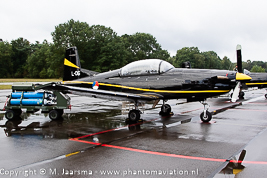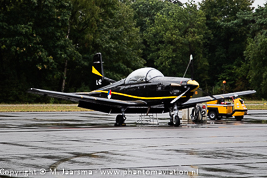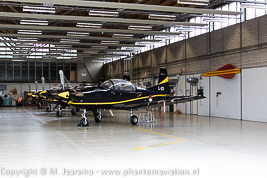
 |
|
| 131 EMVO squadron |
| Latest update: June 2020 |
|
131 EMVO (Elementaire
Militaire Vlieger Opleiding – Elementary Military Flying Training)
squadron celebrated her 30th anniversary in
2018.
The squadron was activated on October 10, 1988. It’s responsible for
training of all future Royal Netherlands Air Force and Navy pilots. The
later for 860 squadron which is equipped with the NHI NH90-NFH and based
at De Kooy. Before EMVO stood up the Dutch basic pilot training phase was conducted at the Euro-NATO Joint Jet Pilot Training Program (ENJJPT) at Sheppard AFB, Texas. As the RNLAF was faced with a high percentage of students not completing the training syllabuses it decided to start training its pilots at Woensdrecht before sending them to the United States. EMVO was born and adopted the crest MEA DOCTRINA VOLANTES’ (Through my lessons they learn to fly). |
| Main Support Base Woensdrecht |
| The squadron is based at RNLAF Air Base Woensdrecht in the province of Noord Brabant and just south of the city of Bergen op Zoom. It’s the RNLAF main support base and houses the Royal Air Force Military School (KMSL - Koninklijke Militaire School Luchtmacht) and Logistics Centre Woensdrecht (LCW). The LCW provides maintenance on almost all RNLAF aircraft types and maintains the supplies. Currently construction takes place to house both the F-35 Lightning II engine maintenance center and a warehouse to store and distribute spare parts for the European area of F-35 operators. The opposite part of the base is used by civilian companies specialized in aircraft maintenance. |
| EMVO 2019 |
|
On April 1, 2019 Major Remy Helmhout assumed command of EMVO. The major
was the commanding officer of 299 squadron at Gilze-Rijen. Squadron
commander positions are normally assigned for a three-year term but CLSK
(RNLAF command) asked the major to accept a reassignment. His roots
within the RNLAF trace back to 1989 where he was a student in the third
EMVO class continuing in the
first VVO class (Voortgezette Vlieger Opleiding – Advanced Flight
Training). Throughout his career the major accumulated over 4.500 flying
hours almost all of them on the different helicopter types operated by
the RNLAF and over 40% (1.700+ hours) of these as an instructor pilot. EMVO is tasked by the RNLAF Director of Personnel and Operations who provides the number of pilots to be trained for its weapon systems (fighter, transport, helicopter and UAV aircraft). The selection of new personnel is carried out by the Center for People and Aviation located in Soesterberg. People who have applied to become a pilot and who have passed all physiological and mental test will start their RNLAF career at the Koninklijke Militaire Academie (KMA - Royal Military Academy). Graduates continue their training at the KMSL where EMVO (C-131 EMVO Sqn) is responsible for the MPL-TK (Military Pilot License – Theoretical Knowledge) course. During six-months they will be taught the theoretical part of aviation including conducting aircraft checks, briefings etc. After completing the MPL-TK course they will be assigned to a class of EMVO and start their basic pilot training. The squadron currently runs four basic pilot training courses annually. Each class is comprised of between 8 to 12 students. In the past EMVO also ran the VVO course but this type of training has been dropped from its tasking. Each student is entitled to request his/her preferred future weapon system based on the on the available positions. They will need to submit their motivation letter explaining their choice. Their future positioning decision is however taken by the EMVO commander and his three ‘vakoudsten’ the most senior staff of IP’s from the fighter, air transport and helicopter community. “The decision is taken on who we consider the most suitable for a system and placement. Currently the Defence Helicopter Command has the highest demand for new pilots. About 70 to 80 percent of the students continue their training at Fort Rucker, Alabama when selected to fly the Boeing CH-47D/F Chinook AH-64D Apache. New pilots assigned for either the AS532-U2 Cougar or NH90-NFH will be send to the German Army international helicopter training center at Bückeburg. The remaining positions are allocated to the ENJJPT." The Ministry of Defence faced a long period of annual budget cuts resulting in shortage of qualified personnel and supplies throughout its armed forces. This also affected the work of EMVO resulting in a high workload for both maintenance personnel as well as IP’s. The former commander, Col. Ben Kamstra, was forced to halt pilot training in February. After short period used to implement improvements the flying operations were resumed. Currently the squadron has eight instructor pilots assigned (excluding the squadron commander and operations officer). |
| Instructor and student pilots |
|
Captain
Pieter is one of the EMVO instructor pilots (IP). After graduation from
EMVO he continued flying the CH-47D Chinook first at Fort Rucker
followed by his operational posting at 298 squadron at Gilze-Rijen AB.
In 2016 he joined EMVO to become an IP. The cadre of instructors consist
of two type of pilots. Aviators who already were an IP on another
aircraft and pilots who will need to be trained to become an instructor.
Both must complete the PC-7 Type Rating Course which takes about three
months to complete. The later however are to complete the IP conversion
training program which takes six months. Capt. Pieter explains. “You
will become an instructor and learn how to judge a student and how to
create an environment in which the student can learn. You learn what he
or she needs and are discussing instructing skills. How do you
communicate with the student.
We must make the translation from instructions to how these are
interpreted by the student. As example, we must guide the student. The
IP needs to steer the head of a student while flying a demo, if you want
a student to look at what you want them to look at you will have to tell
the student." The basic pilot training syllabus is dived into three blocks with a total amount of 30 flying hours which takes, depending on the weather circumstances, 12 to 13 weeks to complete. Block 1 is focused on basic flight training, block 2 on IFR flights and block 3 on performing flying circuits including the students solo flight. EMVO has three training areas available to conduct its training. Area 1 and 1A are located over Woensdrecht and its CTR. Area 2 is the military training area designated TMA-D (Breda – Dordrecht - Drunen – Belgian border back to Breda). Area 3 is located over Walcheren, the peninsula in the west of the Dutch province of Zeeland. This area is part of the Schiphol FIR. Capt. Pieter explains the training giving after graduates arrive from the KMSL. “At the ground school all theory related to flying the PC-7 is taught and trained. EMVO puts theory into practice. During the first briefing students receive information what is expected from them during their training and the briefing processes are explained. The ‘walk around the aircraft’ is conducted. We use Cockpit Procedure Trainers (CPT) to train the aircraft start-up procedure and the items students should pay attention to. The PC-7 has two seats with the front seat used by the student. The rear seat lacks a few switches which are available in the front. IP’s must make sure that the students understands what needs to be done in emergency situations. These procedures are checked during the daily briefings where students either must write down all steps during a certain emergency or one of them is selected in a stand-up session and must describe all actions to be executed in detail in front of the class. The first two take-offs during block 1 are executed by the IP. Our first flight is dedicated to get the student acquainted with Woensdrecht AB and its CTR. Students will also receive information where they must pay attention to for their next flight. From the third flight they are taught to take-off and fly to the ‘mission area’ themselves. There they will train VFR flights, straight and level flights, turns, climbs and descents, aircraft landing configuration and stalls. For all these maneuvers good weather is needed. When weather dictates we will conduct the training above the cloud base. We teach our students to look outside and not at the instruments, focus on the aircraft nose position which forms a good basis for the remainder of the flights. As the IP’s put it Look outside, check inside. Block 2 and 3 flights are flown simultaneously. Students are taught to fly circuits and how to land the aircraft. Basic maneuvers have now to be flown on instruments. Students will now be seated in the rear cockpit. A hood will cover this part of the canopy preventing the student to look outside to fly the aircraft. Although there isn’t a 1:1 relation between the IP and student EMVO tries to assign an IP to the same students as much as possible. Each of the IP’s has two or three students to train. The IP’s work with grade sheets for the students which enables their colleagues to easily read what the student is good in as well as the items that require attention. |
| Pilatus PC-7 |
|
From the start of its operations EMVO has been assigned the Pilatus
PC-7. Originally ten
aircraft were purchased which were delivered from 1989. An additional
order was placed for three aircraft in 1997. As the Ministry of Defence
was faced with a very long period of budget cuts the RNLAF didn’t have
the funds to upgrade its trainers. The situation changed from 2016 when
the government increased the budget for the department of defence.
Pilatus was awarded a contract to upgrade all 13 aircraft. The aircraft
received a digital cockpit but as aircraft were already stripped
preventive maintenance was also conducted. Trusses were strengthened and
tail surfaces replaced. On May 2, 2016 the first PC-7, coincidingly
L-01, was flown to the Pilatus plant at Stans, Switzerland. It was used
as a ‘test-bed’ for all other aircraft and therefore spend 14 months at
Stans. On August 10, 2018 the upgrade process was completed with the
arrival of L-13 at Woensdrecht. The updates to the PC-7 lead to changes to be applied to the training syllabus based on the Pilatus aircraft manual. The main difference for the IP’s was related to the altimeter. In the analog PC-7 both meters could show a different value. The deviation of the parameters became larger due to the age of the aircraft. With the new digital cockpit both pilots now receive the same information on their displays. For students it will now be easier to convert to other aircraft as these are already fitted with digital cockpits or will be when the new or retrofitted aircraft will come online. |
| 5th Generation Air Force and EMVO future |
|
The RNLAF is currently in the transition to the fifth-generation air
force. Several transition projects will lead to this ‘new’ air force.
It’s not only aimed at acquiring and introducing new weapon systems but
also other ways of thinking and working. Fifth generation currently
aircraft on strength are the NH90-NFH and F-35A (322 squadron at
Leeuwarden AB and training by NODF-35, 308 FS at Luke AFB, AZ). The
CH-47F ‘CAAS II’ is fielded to 302 squadron at Fort Hood, TX to train
crews with sister 298 squadron to start flying its new Chinook in the
next few months. 306 squadron based at Leeuwarden will receive its four
MQ-9 Reapers from the end of 2021 adding another 5th Generation Air
Force tool into the RNLAF toolbox. Maj. Helmhout tells CLSK has started a working group to investigate how the future of EMVO should look like. “The impact on EMVO should be limited and might only affect the training for pilots recruited to fly the MQ-9 Reaper which was selected as the RNLAF Medium Altitude Long Endurance Unmanned Aerial Vehicle (MALE UAV). Future MQ-9 pilots are by US law required to be licensed aviators. The first class of MQ-9 operators is trained by the 49th Wing at Holloman AFB, New Mexico. A specific recruiting campaign has been started by the RNLAF for its future MQ-9 pilots. For all other weapon systems the ‘normal’ recruiting process is in place. Somewhere at the end of 2020 or during 2021 the first MQ-9 pilots will start their training at EMVO. If they will use the same syllabus as the other students is unknown at this moment. It’s being investigated by the CLSK working group who will define the training criteria.” While EMVO faced challenges back in 2019 its leaders and staff are working on the future. It plans to train 15 students in each of the four annual classes delivering 60 new pilots to the Director of Personnel and Operations. The number of IP’s should also rise to the 15 required pilots. Although the PC-7 just received their major upgrade the Ministry of Defence already started the trainer replacement project. On December 16, 2020 State Secretary of Defence Mrs. Barbara Visser wrote to parliament that the PC-7 fleet will be replaced from 2027. The maximum amount of flight hours or landings is expected to be reached in that year. The DoD is now investigating how it will replace the PC-7 which might not be done on a one-on-one basis. Items investigated are the use of a simulated environment, international cooperation, and the option to lease the replacement aircraft. The demand for new pilots will only increase but the dedicated ground and flying staff are more than ready to deliver 5th generation pilots from EMVO to their next career fields within the RNLAF. |
| The author would like to thank Major Remy Helmhout commander 131 EMVO squadron and Captain Pieter 131 squadron instructor pilot for their time and hospitality. |
| Photo gallery |
 |
 |
 |
| One of the PC-7s on the flightline. | Returned from a flight. | Capt. Pieter in front of the trainer. |
 |
||
| After the flights and line maintenance the Pilatus are towed into the hangar. |
|
|